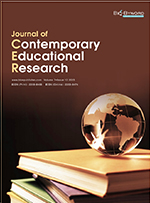Abstract
In recent years, the blended teaching model in Chinese universities has developed rapidly, breaking through the time and space constraints of the teaching process and enriching teaching resources. The emergence of different teaching platforms has also actively promoted the modern development of education. However, there is still room for continuous optimization and development of blended learning, and issues such as some students’ inability to effectively utilize online resources, inability to conduct in-depth learning, lack of thinking training, and insufficient ability cultivation and improvement require resolution. This article fully utilizes the basic concepts of deep learning in the existing blended teaching mode, proposes a blended teaching design based on deep learning, and enriches the existing student assessment and evaluation methods, thereby improving the teaching effectiveness of existing blended teaching, deepening the achievements of teaching reform, and improving teaching quality.
References
Soesmanto T, Vu XB, Kariyawasam K, 2023, Evaluation of the Mixed-Mode Teaching Design Upon Students’ Learning Satisfaction and Academic Performance in an Introductory Economics Course. Studies in Educational Evaluation, 2023(77): 101253. https://doi.org/10.1016/j.stueduc.2023.101253
Chen J, 2023, The Development of Hybrid Teaching in Higher Education in the Era of “Internet Plus” -A Review of Hybrid Teaching Design and Practice. Science and Technology Management Research, 43(01): 237.
Zhang Q, Zhang M, Yang C, 2022, The Current Situation, Challenges, and Suggestions of Blended Teaching Readiness Among University Teachers. Research on Electronic Education Research, 43(01): 46–53. https://doi.org/10.13811/j.cnki.eer.2022.01.006
Guo Y, 2017, On Deep Teaching: Origins, Foundations, and Concepts. Education Research and Experiment, 2017(3): 1–11.
Hale CR, Barsalou LW, 1995, Explanation Content and Construction During System Learning and Troubleshooting. Journal of the Learning Sciences, 1995(4): 385–436.
Bai D, Yu H, 2023, Design and Application Effects of Blended Teaching in the Perspective of Deep Learning: Taking the Course of “Pathophysiology” as an Example. Modern Education Technology, 33(03): 84–90.
Shen X, Yuan D, Chen H, 2022, From “Mixed” to “Integrated”: Design and Practice of Integrated Teaching. Modern Education Technology, 32(04): 40–49.
Li Z, Sun J, 2022, A Study on the Operating Mode and Countermeasures of Blended Teaching in China: A Case Studyof 44 Universities Under the China Finance and Economics MOOC Alliance. China University Teaching, 2022 (Z1): 88-95.
Ahlstrom LJ, Harter C, Asarta CJ, 2023, Teaching Methods and Materials in Undergraduate Economics Courses: School, Instructor, and Department Effects. International Review of Economics Education, 2023(44): 100270. https://doi.org/10.1016/j.iree.2023.100270
